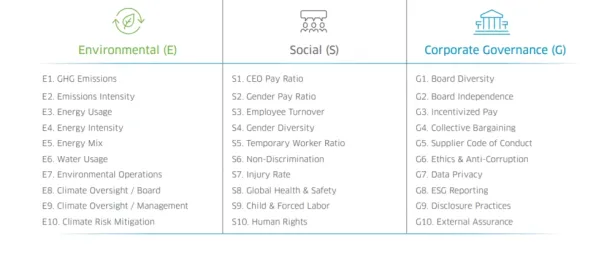Top 14 ESG Metrics CEOs Must Disclose in ESG Reports (2024)
Many European companies will be required to publish environmental social and governance (ESG) reports by 2023 in order to comply with CSRD requirements. AIMultiple predicts that similar regulations will become more widespread globally over this decade. 90% of S&P 500 companies have already publicly disclosed some of their ESG indicators as of the end of 2019, since investors and consumers expect such information.
However, many executives admit that finding the ESG metrics to disclose their non-financial performance is challenging for them. In this article, we will look at what essential ESG indicators and metrics (see Figure 1) CEOs should be aware of when compiling an ESG report, as well as how organizations might compute these metrics.
Figure 1: Key ESG metrics:

Environmental ESG metrics
- 1. Greenhouse gas (GHG) emissions: It is equal to the total emission of gasses that leaps heat into the atmosphere like carbon dioxide, metan, nitrous oxide and so on. One of the most important indications of a company’s impact on climate change is the number of tons of GHG emissions it produces. In 2019, 80% of Nasdaq corporations reported their greenhouse gas emissions. You can read our article “4 Steps to Calculate the Carbon Footprint of Your Organization” to see how your organization can calculate its GHG emissions. We recommend firms to automate their carbon footprint measurement process. To find the best carbon footprint automation tools you can read our Top 7 Carbon Footprint Calculator Software/Tools for Businesses article.
- 2. Emissions intensity: It is the total GHG emissions of a company divided by its total output. Emission intensity can be calculated in a variety of ways, including per product or per dollar. In 2019, 46% of Nasdaq companies reported their emissions intensity.
- 3. Energy mix: Even if a corporation consumes a lot of energy, it can still be carbon neutral if the electricity comes from renewable sources like wind or solar energy. In this sense, a company’s energy mix reveals the percentage of energy sources it employs. In 2019, 7% of Nasdaq businesses made their energy mix public.
- 4. Total water consumption: According to the United Nations, 2.3 billion people lack access to safe drinking water. As a result, water usage in relation to business consumption is an essential environmental factor to address for stakeholders. In 2019, 3% of Nasdaq companies publicly disclosed their total water consumption.
Recommendations: Companies can make decisions to lessen their negative environmental impact by establishing a sustainability department led by a chief sustainability officer. You can use technologies like public cloud, 3D truck loading, route optimization tools, smart devices, to reduce your GHG emissions, as we discussed in our 5 Ways to Reduce Corporate Carbon Footprint, Top 4 Digital Technologies that Improve Corporate Sustainability and Top 5 Technologies Improving Supply Chain Sustainability articles.
- 5. CEO pay ratio: It is computed by dividing the CEO’s total earnings, including bonuses, by the company’s median compensation. The higher the ratio, the less equal the distribution of turnover is, and it can cause employee dissatisfaction.
- 6. Gender diversity: It is the proportion of men and women who work for a company. Discrimination can be measured using gender diversity as a parameter. Creditors and consumers, for example, can compare a company’s gender diversity to the gender diversity of other companies in the same industry. The gender diversity metric was released by 85% of Nasdaq companies in 2019.
- 7. Gender pay ratio: It is calculated by dividing the median male earnings in a company by the median female earnings. It is an important statistic for stakeholders’ judgments of gender-based discrimination. If men hold top-tier managerial positions or earn more money while doing the same job as women, this indicates gender-based discrimination known as occupational segregation.
- 8. Injury Rate: It is computed by frequency of injury events to total work time. Such data might be illuminative to stakeholders to decide whether to further cooperate with your company or not. since they can compare the injury rate of companies within the same industry.
- 9. Child or forced labor: It assesses whether a corporation adheres to international standards about prevention of child or forced labor. Global Reporting Initiative (GRI) 408 and 409 or Sustainability Accounting Standards Board (SASB) human capital practices are examples of such standards. 67% of Nasdaq companies adhered to one or more international standards in 2019.
- 10. Human rights: It evaluates whether your organization adheres to an international human rights standard such as GRI 412. This indicator is reported by 83% of Nasdaq businesses in 2019.
Recommendations: Start tracking social key metrics periodically to see where your current pain spots are. Then start designing strategies to reduce your company’s negative societal impact, such as closing the wage gap between men and women. Your HR staff can also run anonymous internal polls to identify employee issues and solutions.
Governance ESG metrics
- 11. ESG or any related reporting: It shows whether or not a corporation reports its environmental impact orissue an ESG report. In 2019, 13% of Nasdaq businesses issued an ESG or an ESG-like report.
- 12. Incentives pay: It determines if executives have a bonus program as part of their environmental or social development. Consider, the board of directors decides on a 10% reduction in GHG emissions for the entire field sales team until the end of the year. If the KPIs are aligned, those who contributed to this success should be rewarded in order to encourage staff to work on other environmental and social concerns. In 2019, 42% of Nasdaq companies introduced bonuses for their proactive employees.
- 13. Supplier code of conduct: In order to continue trading in 2019, 40% of Nasdaq businesses put environmental or social standards on their suppliers or buyers (e.g., a particular limit of GHG emissions). Businesses should nudge their supply chains to act responsibly because our social and environmental problems can only be solved collectively.
- 14. External Audit: Financial regulations require corporations to declare their financial variables under third-party evaluation. The same should be true for ESG reporting. ESG reports are more credible when they are produced in consultation with a third-party.
Recommendations: Begin collaborating with third parties to complete your ESG report. Affirm that particular teams will receive bonuses if they achieve certain environmental or social ratios. Inform your supply chain about your proactive social and environmental endeavor and compel them to participate in the transformation.
Please contact us if you have further questions regarding ESG metrics:

Cem has been the principal analyst at AIMultiple since 2017. AIMultiple informs hundreds of thousands of businesses (as per similarWeb) including 60% of Fortune 500 every month.
Cem's work has been cited by leading global publications including Business Insider, Forbes, Washington Post, global firms like Deloitte, HPE, NGOs like World Economic Forum and supranational organizations like European Commission. You can see more reputable companies and media that referenced AIMultiple.
Throughout his career, Cem served as a tech consultant, tech buyer and tech entrepreneur. He advised businesses on their enterprise software, automation, cloud, AI / ML and other technology related decisions at McKinsey & Company and Altman Solon for more than a decade. He also published a McKinsey report on digitalization.
He led technology strategy and procurement of a telco while reporting to the CEO. He has also led commercial growth of deep tech company Hypatos that reached a 7 digit annual recurring revenue and a 9 digit valuation from 0 within 2 years. Cem's work in Hypatos was covered by leading technology publications like TechCrunch and Business Insider.
Cem regularly speaks at international technology conferences. He graduated from Bogazici University as a computer engineer and holds an MBA from Columbia Business School.
To stay up-to-date on B2B tech & accelerate your enterprise:
Follow on

Comments
Your email address will not be published. All fields are required.